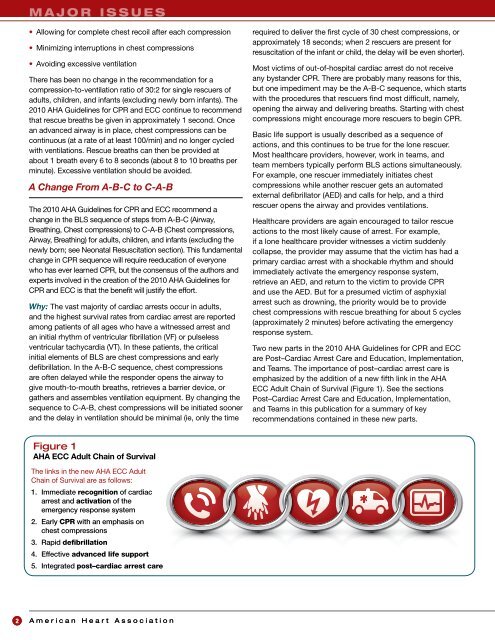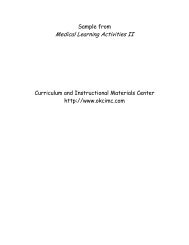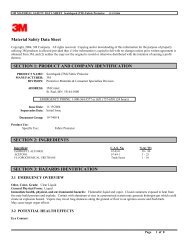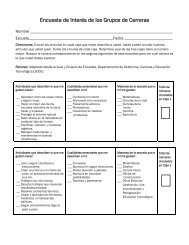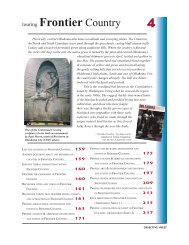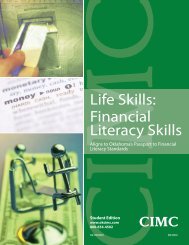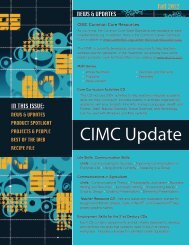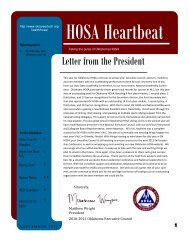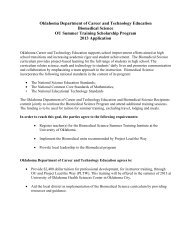Highlights of the 2010 Guidelines for CPR and ECC - ECC Guidelines
Highlights of the 2010 Guidelines for CPR and ECC - ECC Guidelines
Highlights of the 2010 Guidelines for CPR and ECC - ECC Guidelines
You also want an ePaper? Increase the reach of your titles
YUMPU automatically turns print PDFs into web optimized ePapers that Google loves.
lm ay j or r e sI cs us ue r e sa d u lt c p r<br />
• Allowing <strong>for</strong> complete chest recoil after each compression<br />
• Minimizing interruptions in chest compressions<br />
• Avoiding excessive ventilation<br />
There has been no change in <strong>the</strong> recommendation <strong>for</strong> a<br />
compression-to-ventilation ratio <strong>of</strong> 30:2 <strong>for</strong> single rescuers <strong>of</strong><br />
adults, children, <strong>and</strong> infants (excluding newly born infants). The<br />
<strong>2010</strong> AHA <strong>Guidelines</strong> <strong>for</strong> <strong>CPR</strong> <strong>and</strong> <strong>ECC</strong> continue to recommend<br />
that rescue breaths be given in approximately 1 second. Once<br />
an advanced airway is in place, chest compressions can be<br />
continuous (at a rate <strong>of</strong> at least 100/min) <strong>and</strong> no longer cycled<br />
with ventilations. Rescue breaths can <strong>the</strong>n be provided at<br />
about 1 breath every 6 to 8 seconds (about 8 to 10 breaths per<br />
minute). Excessive ventilation should be avoided.<br />
A Change From A-B-C to C-A-B<br />
The <strong>2010</strong> AHA <strong>Guidelines</strong> <strong>for</strong> <strong>CPR</strong> <strong>and</strong> <strong>ECC</strong> recommend a<br />
change in <strong>the</strong> BLS sequence <strong>of</strong> steps from A-B-C (Airway,<br />
Breathing, Chest compressions) to C-A-B (Chest compressions,<br />
Airway, Breathing) <strong>for</strong> adults, children, <strong>and</strong> infants (excluding <strong>the</strong><br />
newly born; see Neonatal Resuscitation section). This fundamental<br />
change in <strong>CPR</strong> sequence will require reeducation <strong>of</strong> everyone<br />
who has ever learned <strong>CPR</strong>, but <strong>the</strong> consensus <strong>of</strong> <strong>the</strong> authors <strong>and</strong><br />
experts involved in <strong>the</strong> creation <strong>of</strong> <strong>the</strong> <strong>2010</strong> AHA <strong>Guidelines</strong> <strong>for</strong><br />
<strong>CPR</strong> <strong>and</strong> <strong>ECC</strong> is that <strong>the</strong> benefit will justify <strong>the</strong> ef<strong>for</strong>t.<br />
Why: The vast majority <strong>of</strong> cardiac arrests occur in adults,<br />
<strong>and</strong> <strong>the</strong> highest survival rates from cardiac arrest are reported<br />
among patients <strong>of</strong> all ages who have a witnessed arrest <strong>and</strong><br />
an initial rhythm <strong>of</strong> ventricular fibrillation (VF) or pulseless<br />
ventricular tachycardia (VT). In <strong>the</strong>se patients, <strong>the</strong> critical<br />
initial elements <strong>of</strong> BLS are chest compressions <strong>and</strong> early<br />
defibrillation. In <strong>the</strong> A-B-C sequence, chest compressions<br />
are <strong>of</strong>ten delayed while <strong>the</strong> responder opens <strong>the</strong> airway to<br />
give mouth-to-mouth breaths, retrieves a barrier device, or<br />
ga<strong>the</strong>rs <strong>and</strong> assembles ventilation equipment. By changing <strong>the</strong><br />
sequence to C-A-B, chest compressions will be initiated sooner<br />
<strong>and</strong> <strong>the</strong> delay in ventilation should be minimal (ie, only <strong>the</strong> time<br />
required to deliver <strong>the</strong> first cycle <strong>of</strong> 30 chest compressions, or<br />
approximately 18 seconds; when 2 rescuers are present <strong>for</strong><br />
resuscitation <strong>of</strong> <strong>the</strong> infant or child, <strong>the</strong> delay will be even shorter).<br />
Most victims <strong>of</strong> out-<strong>of</strong>-hospital cardiac arrest do not receive<br />
any byst<strong>and</strong>er <strong>CPR</strong>. There are probably many reasons <strong>for</strong> this,<br />
but one impediment may be <strong>the</strong> A-B-C sequence, which starts<br />
with <strong>the</strong> procedures that rescuers find most difficult, namely,<br />
opening <strong>the</strong> airway <strong>and</strong> delivering breaths. Starting with chest<br />
compressions might encourage more rescuers to begin <strong>CPR</strong>.<br />
Basic life support is usually described as a sequence <strong>of</strong><br />
actions, <strong>and</strong> this continues to be true <strong>for</strong> <strong>the</strong> lone rescuer.<br />
Most healthcare providers, however, work in teams, <strong>and</strong><br />
team members typically per<strong>for</strong>m BLS actions simultaneously.<br />
For example, one rescuer immediately initiates chest<br />
compressions while ano<strong>the</strong>r rescuer gets an automated<br />
external defibrillator (AED) <strong>and</strong> calls <strong>for</strong> help, <strong>and</strong> a third<br />
rescuer opens <strong>the</strong> airway <strong>and</strong> provides ventilations.<br />
Healthcare providers are again encouraged to tailor rescue<br />
actions to <strong>the</strong> most likely cause <strong>of</strong> arrest. For example,<br />
if a lone healthcare provider witnesses a victim suddenly<br />
collapse, <strong>the</strong> provider may assume that <strong>the</strong> victim has had a<br />
primary cardiac arrest with a shockable rhythm <strong>and</strong> should<br />
immediately activate <strong>the</strong> emergency response system,<br />
retrieve an AED, <strong>and</strong> return to <strong>the</strong> victim to provide <strong>CPR</strong><br />
<strong>and</strong> use <strong>the</strong> AED. But <strong>for</strong> a presumed victim <strong>of</strong> asphyxial<br />
arrest such as drowning, <strong>the</strong> priority would be to provide<br />
chest compressions with rescue breathing <strong>for</strong> about 5 cycles<br />
(approximately 2 minutes) be<strong>for</strong>e activating <strong>the</strong> emergency<br />
response system.<br />
Two new parts in <strong>the</strong> <strong>2010</strong> AHA <strong>Guidelines</strong> <strong>for</strong> <strong>CPR</strong> <strong>and</strong> <strong>ECC</strong><br />
are Post–Cardiac Arrest Care <strong>and</strong> Education, Implementation,<br />
<strong>and</strong> Teams. The importance <strong>of</strong> post–cardiac arrest care is<br />
emphasized by <strong>the</strong> addition <strong>of</strong> a new fifth link in <strong>the</strong> AHA<br />
<strong>ECC</strong> Adult Chain <strong>of</strong> Survival (Figure 1). See <strong>the</strong> sections<br />
Post–Cardiac Arrest Care <strong>and</strong> Education, Implementation,<br />
<strong>and</strong> Teams in this publication <strong>for</strong> a summary <strong>of</strong> key<br />
recommendations contained in <strong>the</strong>se new parts.<br />
Figure 1<br />
AHA <strong>ECC</strong> Adult Chain <strong>of</strong> Survival<br />
The links in <strong>the</strong> new AHA <strong>ECC</strong> Adult<br />
Chain <strong>of</strong> Survival are as follows:<br />
1. Immediate recognition <strong>of</strong> cardiac<br />
arrest <strong>and</strong> activation <strong>of</strong> <strong>the</strong><br />
emergency response system<br />
2. Early <strong>CPR</strong> with an emphasis on<br />
chest compressions<br />
3. Rapid defibrillation<br />
4. Effective advanced life support<br />
5. Integrated post–cardiac arrest care<br />
32 A m e r i c a n H e a r t A s s o c i a t i o n


